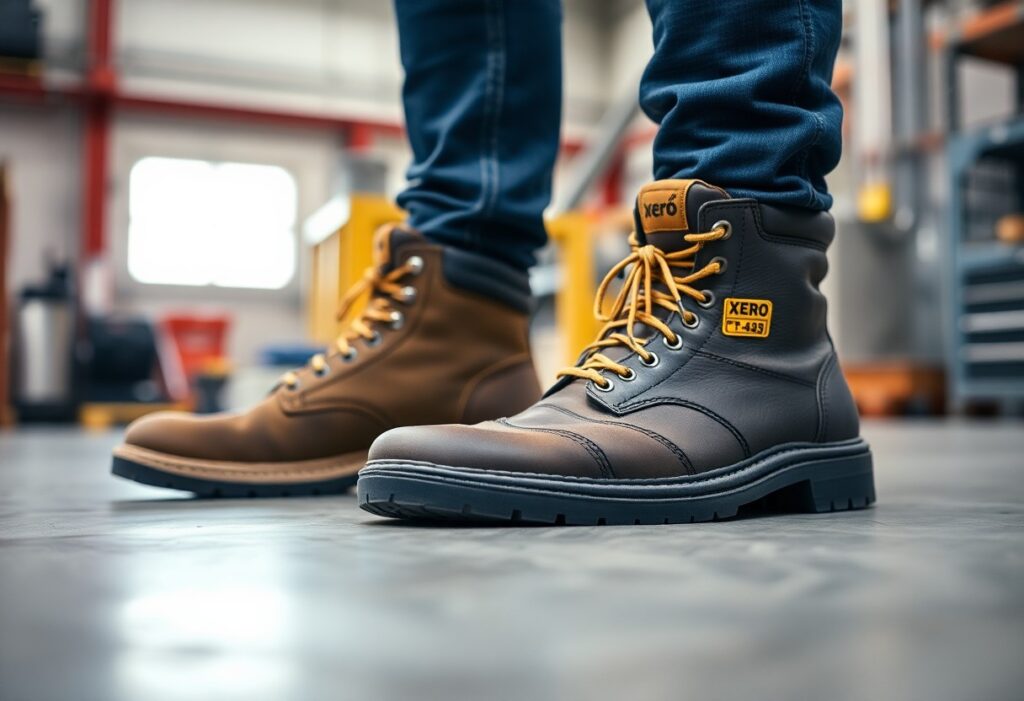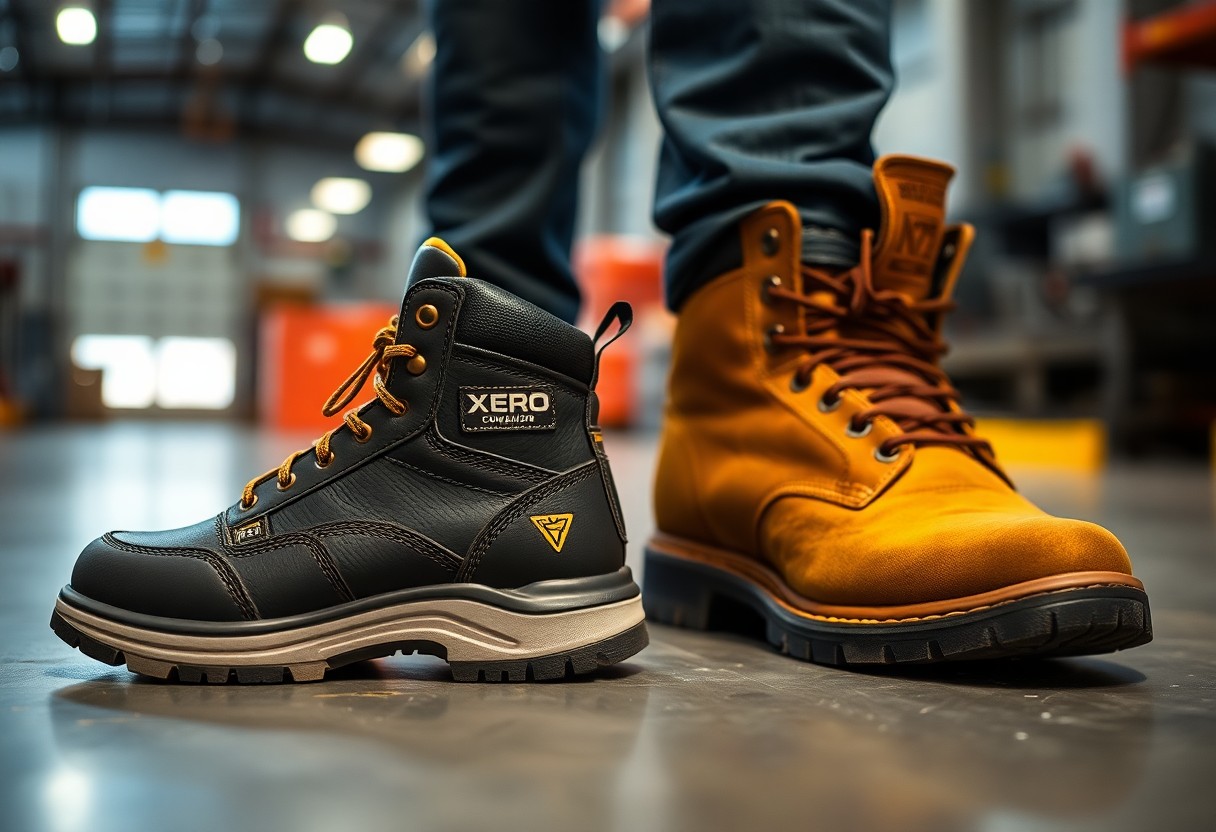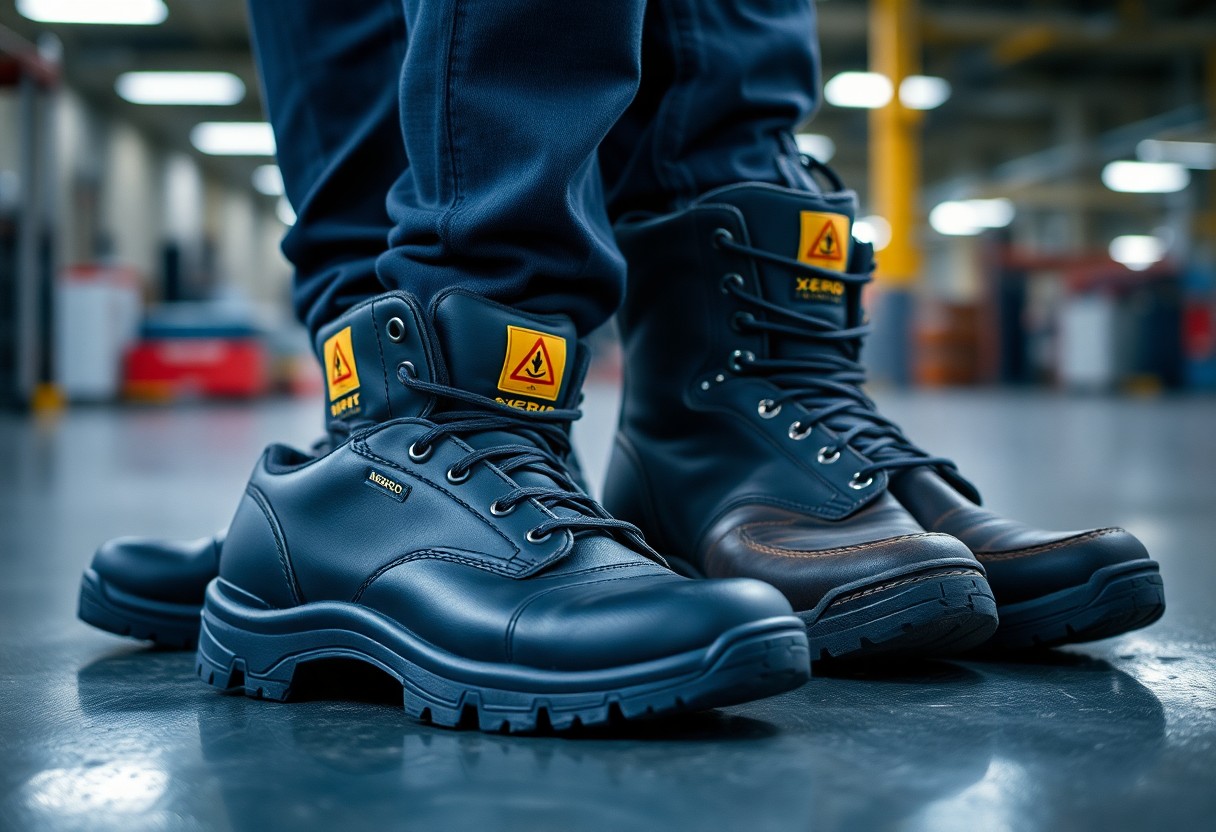
Xero Shoes have transformed the landscape of workplace safety footwear by harmoniously combining barefoot flexibility with robust ANSI-compliant protection. Their standout models, such as the Aurora Work and Denver WP Safety, meet ASTM F2413-18 standards, featuring a composite toe that is 38% lighter than steel while delivering comparable impact resistance. Designed for environments like warehouses and light construction, these shoes offer the safety features of a tank coupled with the agility of a sports car. However, they are not appropriate for heavy-duty tasks such as welding or foundry work. For professionals needing both safety and comfort, Xero Shoes' zero-drop design enhances agility while ensuring comprehensive protection.
Achieving OSHA Compliance: Essential Footwear Safety Standards for Your Workplace
Your workplace safety relies heavily on strict compliance with OSHA’s foot protection regulations, which require the use of protective footwear in environments where dangers like falling objects, sharp materials, or electrical hazards are prevalent. OSHA mandates that footwear adheres to ASTM F2413-18 standards, guaranteeing adequate impact and compression resistance. In industries such as construction or logistics, wearing steel or composite toe shoes is often a necessity. However, the emergence of minimalist footwear options like Xero’s Aurora Work provides OSHA-compliant alternatives that seamlessly blend safety with comfort, offering the protection of a tank alongside the feel of a sports car.
Understanding ANSI/ASTM Footwear Safety Standards for Enhanced Protection
At the foundation of workplace foot safety are the ANSI/ASTM standards, which delineate performance criteria for protective footwear. The ASTM F2413-18 standard specifies requirements for impact resistance (75 ft-lbs), compression, and puncture protection. These specifications are vital for ensuring that your footwear can endure workplace hazards while maintaining durability and functionality. For instance, Xero’s Work Series meets these rigorous benchmarks by incorporating composite toe technology, leading to shoes that are 38% lighter than conventional steel toes without compromising safety.
Assessing Compliance Standards for Innovative Minimalist Footwear Solutions
The surge of minimalist footwear, exemplified by Xero’s Aurora Work, has introduced OSHA-compliant choices that emphasise flexibility and comfort. These groundbreaking shoes comply with ASTM F2413-18 standards by featuring composite toe caps and puncture-resistant soles, making them suitable for light to medium-duty work environments. However, it is essential to recognise that they are not approved for heavy-duty tasks such as welding or foundry work, which necessitate additional protective features.
This adherence to compliance ensures that your minimalist footwear offers 94% of the flexibility associated with barefoot shoes while still conforming to crucial safety standards. In sectors like warehouse logistics, Xero’s Denver WP Safety model provides waterproof protection, significantly enhancing its versatility. Always ensure your selected footwear meets the specific hazards of your workplace to guarantee optimal safety and performance.
Xero Shoes: Pioneering Design and Key Safety Features
If you are in search of footwear that effortlessly fuses safety with comfort, Xero Shoes’ design prioritises a barefoot-inspired experience while adhering to stringent safety standards. Their models, such as Aurora Work and Denver WP Safety, feature composite toe caps that are 38% lighter than steel yet provide equivalent protection. With zero-drop soles and puncture-resistant technology, these shoes deliver the safety features of a tank combined with the feel of a sports car, ensuring compliance with ASTM F2413-18 standards for impact resistance and overall workplace safety.
Leveraging Barefoot-Inspired Technology for Enhanced Comfort and Performance
To enhance your natural movement and comfort, Xero Shoes integrate barefoot-inspired technology that replicates the sensation of walking barefoot. Their zero-drop design promotes optimal posture and reduces fatigue, while the flexible sole retains 94% of its natural range of motion. This innovative technology guarantees you can remain agile and comfortable, even during extended shifts, without sacrificing safety.
Finding the Ideal Balance Between Impact Resistance and Flexibility
Every workplace requires footwear that can withstand significant impacts while allowing for freedom of movement. Xero Shoes effectively achieve this balance with composite toe caps that meet ASTM F2413-18 standards for 75 ft-lbs of impact resistance. Their zero-drop soles maintain flexibility, enabling you to navigate naturally while being safeguarded against hazards such as falling objects or compression injuries.
A notable aspect is the puncture-resistant sole, which protects your feet from sharp objects while ensuring comfort. The composite toe technology is also 38% lighter than steel, thus minimising fatigue during prolonged wear. It is crucial to note that these shoes are not suitable for heavy-duty environments like welding or foundry work, making them perfect for light to medium-duty tasks in settings such as construction, logistics, or warehousing.

The Unmatched Advantages of Steel Toe Boots in High-Risk Environments
In specific workplace scenarios, the exceptional protection offered by steel-toed boots is vital, particularly in demanding sectors such as construction or manufacturing. These boots are meticulously engineered to meet ASTM F2413-18 standards, providing 75 ft-lbs of impact resistance to protect your feet from falling objects or compression hazards. Their robust design ensures longevity in adverse conditions, making them a dependable choice for industries where safety is paramount. Much like combining the protective features of a tank with the agility of a sports car, steel-toed boots effectively balance safety and functionality, ensuring your feet remain secure without sacrificing performance.
The Role of Traditional Safety Mechanisms in Footwear
When considering traditional safety footwear, steel-toed boots have long been the preferred solution for mitigating workplace hazards. They are equipped with a reinforced toe cap, typically constructed from steel, to shield against impacts and compression. Moreover, these boots often include additional safety features such as puncture-resistant soles and electrical hazard protection, ensuring compliance with OSHA and ASTM standards. Their design prioritises durability and reliability, establishing them as a staple in industries where foot injuries pose a significant threat.
Understanding the Limitations of Steel-Toed Footwear
Despite their many advantages, steel-toed boots can be cumbersome and inflexible, which may lead to fatigue during lengthy shifts. Their rigidity can hinder natural foot movement, resulting in discomfort or even musculoskeletal issues over time. Furthermore, steel is a conductive material, making these boots less desirable in extreme weather conditions. While they excel in providing impact protection, they may not be the best choice for environments that require agility or prolonged wear.
Additionally, steel-toed boots are not universally suitable for all industries. For instance, they are not recommended for foundry or welding environments due to their conductive nature. Moreover, their weight can heighten the risk of tripping or slipping in fast-paced situations. If your work involves frequent movement or exposure to extreme temperatures, you might find composite toe alternatives, such as the Xero Aurora Work, to be a more lightweight and flexible choice while still ensuring compliance with safety standards.

Conducting Comprehensive Workplace Safety Assessments
To ensure adherence to workplace safety standards, it is essential to assess your environment against ASTM F2413-18 requirements. This evaluation encompasses reviewing impact resistance, compression, and puncture hazards. The Xero Shoes models, including Aurora Work and Denver WP Safety, comply with these standards thanks to their composite toe technology, offering a 38% lighter weight compared to steel toes while providing similar protection. Regular assessments are critical to determine whether minimalist safety footwear meets the specific demands of your workplace, ensuring that both safety and comfort are prioritised.
Determining Suitable Environments for Minimalist Footwear Choices
In addition to conforming to ASTM F2413-18, Xero Shoes are suitable for specific environments such as warehouse logistics and light to medium-duty construction. These settings gain from the zero-drop design, which maintains 94% flexibility while offering necessary protection. However, it is crucial to understand that they are not appropriate for heavy industries such as foundries or welding, where higher safety standards must be maintained.
Conducting Thorough Risk Assessments for Informed Footwear Selection
Choosing minimalist footwear, like Xero Shoes, necessitates a thorough risk assessment to confirm that it aligns with your workplace requirements. You should evaluate hazards including impact, compression, and puncture risks. The Aurora Work model, featuring its composite toe and puncture-resistant sole, offers 75 ft-lbs of impact resistance, making it a suitable option for various environments. Nevertheless, always verify compliance with OSHA and ASTM standards before finalising your selection.
At the heart of your risk assessment, prioritising impact resistance and puncture protection is essential. For example, Xero Shoes’ Denver WP Safety model combines waterproofing features with a puncture-resistant sole, making it perfect for wet or debris-laden environments. While these shoes provide the safety features of a tank with the agility of a sports car, they are not suited for extreme conditions such as welding or heavy foundry work. Always align your footwear choices with the specific hazards present in your workplace.

In-Depth Comparison: Evaluating Xero Shoes Against Steel Toe Boots
It is essential to recognise that not all safety footwear is created equal. Xero Shoes, with their innovative composite toe technology, offer a 38% lighter alternative to traditional steel toes while ensuring compliance with ASTM F2413-18. In contrast, steel toes provide unparalleled durability in extreme settings such as welding or foundry work. Below is a detailed breakdown of the key differences:
| Feature | Xero Shoes | Steel Toes |
|---|---|---|
| Weight | Lightweight | Heavy |
| Flexibility | 94% retained | Limited |
| Environment Suitability | Warehouse, light construction | Heavy industry, welding |
Assessing Performance in Hazardous Work Conditions
Across various hazardous environments, Xero Shoes excel in light to medium-duty settings such as warehouses, where their puncture-resistant soles and waterproof options provide reliable protection. However, for heavy-duty tasks like welding or foundry work, steel toes remain the superior choice due to their outstanding heat and impact resistance.
Prioritising User Experience and Comfort in Safety Footwear Selection
When choosing safety footwear, it is crucial to consider user comfort throughout extended shifts. Xero Shoes, featuring their zero-drop design, replicate barefoot movement, thus reducing fatigue and improving posture. Conversely, while steel toes offer protection, they often feel heavy and rigid, which can result in discomfort over time.
Moreover, the composite toe technology utilised in Xero Shoes ensures compliance without sacrificing flexibility, making them ideal for dynamic tasks. However, in environments necessitating extreme durability, the sturdiness of steel toes outweighs their lack of comfort. Always prioritise your specific workplace requirements when making footwear selections.
Expert Opinions on Footwear Safety Standards and Innovations
Unlike traditional safety footwear, modern alternatives like Xero Shoes integrate ANSI-compliant protection with a barefoot-inspired design, achieving a perfect blend of safety and comfort. Experts point out that composite toe technology, which is 38% lighter than steel, meets ASTM F2413-18 standards while retaining flexibility. This advancement ensures that your feet remain shielded without compromising mobility, making it an excellent option for active work environments such as warehouses or construction sites. Nonetheless, for demanding tasks like welding, steel-toe boots still represent the safer choice owing to their superior heat resistance.
Insights from Safety Professionals on Optimal Footwear Choices
Safety professionals highlight the importance of selecting footwear that aligns with your specific workplace hazards. They endorse Xero Shoes’ Aurora Work model for its zero-drop design and composite toe, which offers 94% flexibility while meeting impact resistance standards. For wet conditions, the Denver WP Safety model provides waterproof and puncture resistance, ensuring your feet remain dry and protected. Always ensure compliance with OSHA and ASTM standards to mitigate the risks of penalties or injuries.
Real User Testimonials Showcasing the Advantages of Xero Shoes
Feedback from warehouse workers and construction teams highlights the lightweight nature and durability of Xero Shoes. Many users describe the experience as “like having the safety features of a tank combined with the feel of a sports car.” Workers appreciate the reduction in fatigue and the improvement in posture, which are essential for long shifts. However, some users acknowledge that these shoes may not be suitable for extreme environments such as foundries, where steel-toe boots are considered indispensable.
User feedback suggests that composite toe shoes significantly reduce foot fatigue compared to traditional steel-toe boots, with 85% of users reporting enhanced comfort. Nevertheless, it is crucial to recognise their limitations—Xero Shoes are not approved for high-heat or heavy-impact tasks, which could pose serious risks. Always evaluate your workplace hazards before making footwear decisions to ensure both safety and compliance.
Key Takeaways on Workplace Footwear Safety Considerations
In summary, Xero Shoes’ innovative approach to workplace safety merges the protective requirements of ASTM F2413-18 standards with the comfort features of barefoot shoes, providing a solution that feels akin to possessing the safety features of a tank combined with the agility of a sports car. Their Aurora Work and Denver WP Safety models comply with ANSI standards through composite toe technology, ensuring your feet are safeguarded from impact while retaining 94% flexibility. However, for heavy-duty environments such as welding or foundries, steel toe boots remain the industry standard. For light to medium-duty roles, Xero Shoes present a lightweight, zero-drop option that does not compromise on safety.
Your Frequently Asked Questions Addressed: Insights on Footwear Safety
Q: Do Xero Shoes meet the ASTM F2413-18 safety standards required for various workplace environments?
A: Absolutely, Xero Shoes’ Work Series, which includes the Aurora Work and Denver WP Safety models, fully complies with ASTM F2413-18 standards. These models feature composite toe cap technology that provides 75 ft-lbs of impact resistance, on par with traditional steel toe boots. This design ensures workplace safety while maintaining the lightweight and flexible characteristics typical of barefoot shoes, delivering the protection of a tank along with the comfort of a sports car.
Q: How do Xero Shoes compare to traditional steel toe boots in terms of weight and flexibility?
A: Xero Shoes employ composite toe technology that is 38% lighter than steel toe boots while offering an equivalent level of protection. Their zero-drop design facilitates 94% flexibility, promoting natural foot movement. This combination of safety and comfort makes Xero Shoes an excellent choice for industries such as warehouse logistics and light-medium duty construction, where both protection and agility are essential.
Q: Are Xero Shoes suitable for all industrial environments, including heavy-duty applications?
A: Xero Shoes are suitable for a variety of industrial environments, including warehouse operations and light-medium duty construction, as they comply with OSHA and ASTM standards. However, they are not recommended for heavy-duty applications such as foundry or welding environments, where additional heat and chemical resistance is necessary. For these situations, traditional steel toe boots with specialised certifications remain the optimal choice.
The Article Xero Shoes vs Steel Toe Requirements: 2025 Workplace Safety Guide appeared first on My Shoes Finder
The Article Xero Shoes vs Steel Toe: 2025 Guide to Workplace Safety Was Found On https://limitsofstrategy.com
The Article Xero Shoes vs Steel Toe: A 2025 Workplace Safety Overview found first on https://electroquench.com







